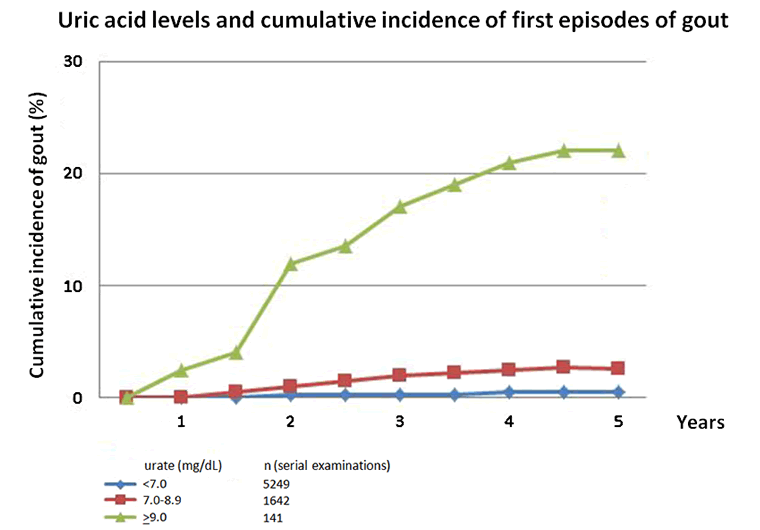Aetiology
There is a causal relationship between hyperuricaemia (high urate level) and gout.
Urate is a metabolite of purines and the ionised form of uric acid (a weak acid at a physiological pH); hence, uric acid exists mostly as urate.
Hyperuricaemia does not always lead to gout, but the incidence of gout increases with urate level. The annual incidence of gout in men is 0.4% for a urate level of 420 to 470 micromol/L (7 to 7.9 mg/dL), 0.8% for 480 to 530 micromol/L (8 to 8.9 mg/dL), 4.3% for 540 to 590 micromol/L (9 to 9.9 mg/dL), and 7% for levels >590 micromol/L (>10 mg/dL).[9][Figure caption and citation for the preceding image starts]: Uric acid levels and cumulative incidence of first episodes of goutAdapted from Campion EW, Glynn RJ, DeLabry LO. Asymptomatic hyperuricemia. Risks and consequences in the Normative Aging Study. Am J Med. 1987;82:421-426 [Citation ends].
Hyperuricaemia is due to renal under-excretion of urate in 90% of cases and to over-production in 10%, although there is often an overlap of both.[10] Aspirin, ciclosporin, tacrolimus, or pyrazinamide can raise serum uric acid level by increasing uric acid re-absorption.[11][12] Diuretics can increase urate levels and are associated with an increased risk of gout.[13][14]
Risk factors for hyperuricaemia may eventually lead to gout, and include dietary factors such as consumption of seafood, meat, and alcohol, especially beer.[14][15][16] Obesity, insulin resistance, and hypertension have also been implicated.[13][17][18]
High cell turnover, such as from haematological cancer and chemotherapy, and specific genetic enzymatic abnormalities, constitute endogenous sources of purine and urate production.[10]
Pathophysiology
Humans and some other higher primates develop gout spontaneously. Humans no longer express the gene for the enzyme uricase, which, in animals, degrades uric acid to the more soluble compound allantoin. This, coupled with a high rate of renal re-absorption of urate, results in hyperuricaemia and gout.[19][20][21][22] Uric acid exists as urate at a physiological pH. High urate levels result in super-saturation and crystal formation, leading to gout. Urate levels directly correlate with risk for gout.[9] Drugs that reduce urate levels decrease the risk of recurrent attacks.[23]
The solubility of urate in the joints depends on temperature, pH, non-aggregated proteoglycans, and other factors. Gout more commonly affects the first metatarsophalangeal joint (cool part of the body) and osteoarthritic joints.[24]
Urate crystals in the joint interact with undifferentiated phagocytes and trigger an acute inflammatory response by inducing tumour necrosis factor (TNF)-alpha and activating signal pathways and endothelial cells.[25] TNF-alpha, interleukin (IL)-8, and other chemokines lead to neutrophil adhesion to endothelium, influx, and amplification, resulting in neutrophilic synovitis.
Colchicine works by intercepting the neutrophil-endothelial interaction.[10][26] IL-8 accounts for 90% of the chemotactic activity of neutrophils in response to uric acid crystals; hence, inhibiting IL-8 may have therapeutic implications.[27][28]
In addition there is evidence that urate crystals activate NALP3 inflammasome (a key regulator of IL-1beta secretion), which plays a role in the gout inflammatory reaction.[29]
Urate crystals can induce chondrocytes to produce metalloproteinase and nitric oxide, and chronic inflammation, leading to synovitis, cartilage loss, bone damage by inhibiting osteoblasts, and bone erosions.[30][31]
Genetic mutations that potentially predispose people to hyperuricaemia and gout have been identified.[32][33][34][35][36] However, further study is required to determine their clinical significance.
Spontaneous resolution of gout attack results from clearance of urate crystals by differentiated phagocytes, coating of the crystals with proteins, neutrophilic apoptosis, and inactivation of inflammatory mediators.[10]
Use of this content is subject to our disclaimer